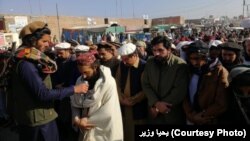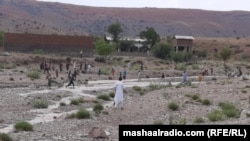Eid Rahman Wazir, an activist in Pakistan’s restive western North Waziristan district, is still hoping for justice after his uncle was assassinated in broad daylight two months ago.
Malak Raees Khan, a notable Pashtun tribal leader in North Waziristan, was killed on November 18 but Wazir says the authorities have made no progress in the case.
“The number of targeted killings has increased in Waziristan,” he told Radio Mashaal. “My uncle was killed in broad daylight in an area where there were many check posts manned by the security forces.”
Khan was among more than 50 people killed in North Waziristan last year, a similar number as the year before. They included tribal leaders, activists, and government officials. Despite their frequent occurrence, such murders are rarely investigated, and few of the perpetrators have been charged. While local activists and officials ascribe various motives to the attacks, there is a consensus that most were linked to the regrouping of Taliban militants who fled the region after a large-scale military operation in 2014.
Residents are deeply worried about the Taliban’s regrouping. More than 1 million Waziristanis endured three years of displacement after the Zarb-e Azb military offensive ended a decade in which Al-Qaeda, Pakistani and Afghan Taliban factions, and Central Asian radicals effectively controlled most of the region bordering Afghanistan and committed large-scale atrocities there.
Malak Gul Saleh Jan, a community leader in Mir Ali, a major town in North Waziristan, has survived several assassination attempts, the most recent of which was last summer.
“I fear for my life,” he told Radio Mashaal. “I still receive threatening phone calls.”
Good And Bad Taliban
In an atmosphere of fear, few are willing to openly discuss the killings. Adil Dawar, a member of the Pashtun Tahafuz Movement (PTM), a civil rights group campaigning for the rights of ethnic Pashtuns, is among those who say the militants are responsible.
“None of these attacks happened because of feuds,” he said of prevalent blood feuds in the region. “Any incident based on personal enmity is often acknowledged by those responsible, and the entire local community knows about it.”
Dawar blames the government’s murky dealings with the militants for the killings.
“The [state] has brought those who fled Zarb-e Azb back from Afghanistan,” he said. “The state does everything through these people.”
He added that the Pakistani Taliban, also known as Tehreek-e Taliban (TTP), wasn’t the only group involved. “The TTP and the ‘good Taliban’ all are involved in such attacks,” he said.
Islamabad’s official stance on the TTP is that the militants are “mortal enemies” who are classified as so-called Bad Taliban. The Good Taliban, on the other hand, include militants who have sided with the Pakistani security forces in the war against the TTP or surrendered to Islamabad after the TTP’s defeat in 2014. Some of them only fight in Afghanistan.
The Pakistani government and the military have repeatedly rejected claims that they support militant groups. Yet many in the region see ulterior motives.
“The location of North Waziristan is ideal for controlling and influencing Afghanistan,” says Noor Islam Dawar, a local activist. “This is a completely controlled game. I see no distinction between insurgents, terrorists, and Good or Bad Taliban,” he added. “From A to Z, they are all part of the same story.”
Part Of A Larger Plan
During the 1980s, North Waziristan was a bastion of the anti-Soviet Afghan mujahedin guerrillas for its strategic location next to Afghanistan’s Khost Province. In the 1990s, it was a stronghold for Jalalauddin Haqqani, a senior leader and minister in the Taliban regime. He retreated to the region after the demise of the Taliban regime in late 2001, which quickly turned the mountainous region into a hub of global and regional jihadist networks.
Adil Dawar, the PTM activist who travels around North Waziristan attending protests demanding security, says locals agree that the targeted assassinations appear to be part of a larger strategic plan.
“Terrorism is being promoted again in Waziristan. As in the past, Waziristan is being prepared to be used against other countries [such as Afghanistan],” he said. “These targeted killings and other security incidents are part of that plan. This is what the masses in Waziristan think.”
At the peak of militant control before the 2014 operation, the security forces relied on human intelligence. Several residents who wished not to be name for fear of reprisals said some locals, including militants from rival groups, were informants for the military and intelligence agencies.
But many among them and others who were considered key players in the region have been killed under mysterious circumstances.
“If you turn a blind eye to everything, do not criticize the wrong and do not support the right, do not work for anyone and lead your daily life quietly, nothing can happen to you,” a local lawyer said on the condition of anonymity.
Government Response
A top security official in North Waziristan rejected the allegations of state or military involvement in allowing the militants to regroup and operate.
Speaking to Radio Mashaal on the condition of anonymity because he is not authorized to talk to the media, he said dozens of soldiers and senior officers have been killed in ambushes and clashes with the militants since 2019.
He said that the military and intelligence officials are constantly engaged in operations against militant groups. “As many as 95 militants, including important commanders and assassins, have been killed in search operations and clashes during the past year,” he said.
Shafiullah Gandapur, the police chief of North Waziristan, confirmed the regrouping and reorganization of militant groups in the district.
“No one can deny the presence of local groups. It is a matter that the army deals with, but if I am not mistaken, fencing [along the border with Afghanistan] has not been completed in some areas,” he told Radio Mashaal while alluding to Islamabad’s stance, which blames Afghanistan for sheltering the TTP. “The Shawal region is completely cordoned off so police and administration do not have access there,” he said of a large part of North Waziristan where the military is still battling the insurgents.
Gandapur said that after the 2018 merger of North Waziristan and six other districts of the former Federally Administered Tribal Areas (FATA), a special police force, the Counterterrorism Department (CTD) was established.
“More than 900 police officers are being trained to counter and investigate terrorism cases,” he said of the progress being made in establishing a robust counterterrorism force. “The police don’t deal with terrorism cases, which are dealt with by the CTD,” he said. “We report incidents to them, but it’s their job to investigate incidents and make arrests,” he added.
Gandapur rejected allegations that the law enforcement often abandons checkpoints after sunset, which helps the militants to operate freely. “The state has not abandoned its people or their security,” he said, adding that he has personally led nighttime patrols in various parts of North Waziristan.
The police chief, however, admits parts of the large region such as Razmak, Shawa, and Spinwam are still awash with unauthorized weapons. “People hid weapons in those areas and they’re still being used,” he said. “We and the military often seize weapons from people there.”
Uncertain Future
But many North Waziristan residents still view the police as reluctant to register cases and investigate targeted killings.
“None of the suspects has been arrested,” Adil Dawar said, adding that police inaction has led to people refusing to report incidents to the police.
The militant leaders, he says, roam freely in towns and villages and have been known to target pro-government people.
“The [militants] kill pro-government people to gain sympathy and show they are really against the state,” he said. “But some senior militant leaders who promote terrorism are free to roam around in tinted-windowed vehicles,” he said. “The security forces only kill low-level militants.”
Journalist Rasool Dawar says not registering cases is an easy way for the police to avoid taking responsibility.
The police must register a First Information Report (FIR), he said. “But they don’t do that [often] because when an FIR is lodged, it becomes part of the [official] record and then people can ask about the perpetrators, arrests. Registering an FIR does not mean the end of the story.”
In such a polarizing and dangerous environment, many North Waziristan residents are choosing silence in their bid to survive.
“If you support the military, the insurgents kill you. If you back the militants, the army will kill you,” one resident said. “Only those who remain silent are not targeted.”
Umar Daraz Wazir, a Radio Mashaal correspondent in North Waziristan, contributed reporting to this story.












